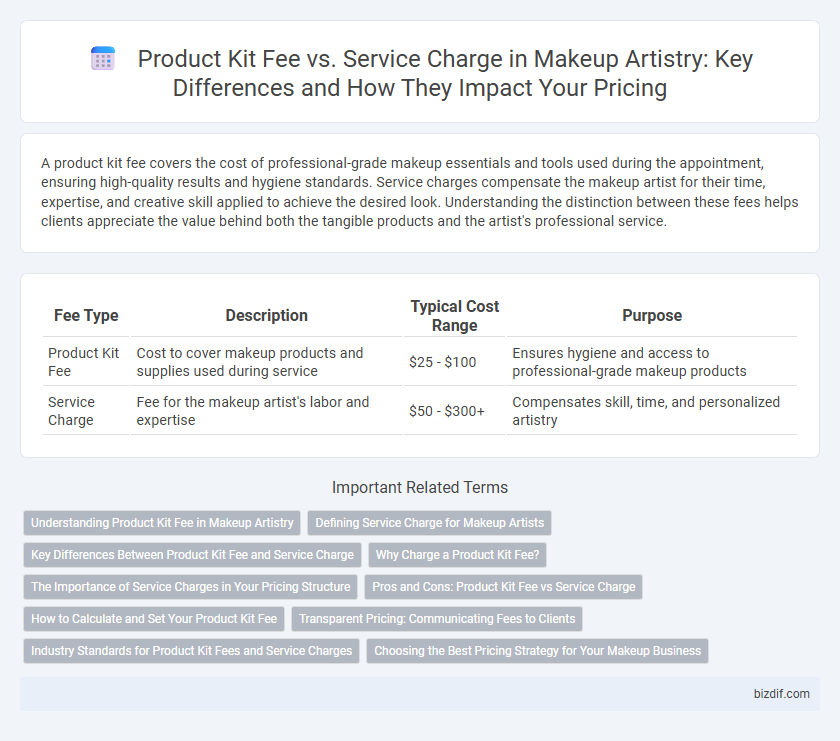A product kit fee covers the cost of professional-grade makeup essentials and tools used during the appointment, ensuring high-quality results and hygiene standards. Service charges compensate the makeup artist for their time, expertise, and creative skill applied to achieve the desired look. Understanding the distinction between these fees helps clients appreciate the value behind both the tangible products and the artist's professional service.
Table of Comparison
| Fee Type | Description | Typical Cost Range | Purpose |
|---|---|---|---|
| Product Kit Fee | Cost to cover makeup products and supplies used during service | $25 - $100 | Ensures hygiene and access to professional-grade makeup products |
| Service Charge | Fee for the makeup artist's labor and expertise | $50 - $300+ | Compensates skill, time, and personalized artistry |
Understanding Product Kit Fee in Makeup Artistry
A product kit fee in makeup artistry refers to the separate charge clients pay to cover the cost of high-quality makeup products and tools used during their appointment. This fee ensures artists can maintain a professional, hygienic, and diverse selection of cosmetic items essential for personalized and flawless looks. Differentiating between the product kit fee and the service charge helps clients understand they are paying both for the skilled application and the premium materials utilized.
Defining Service Charge for Makeup Artists
A service charge for makeup artists refers to a fee added to cover the professional expertise, time, and effort involved in providing makeup services. This fee is distinct from the product kit fee, which covers the cost of makeup products and tools used during the application. Understanding the service charge helps clients recognize the value of the artist's skill and personalized attention beyond the physical materials.
Key Differences Between Product Kit Fee and Service Charge
Product kit fee covers the cost of makeup products and tools used during the session, ensuring clients receive high-quality, hygienic materials tailored to their needs. Service charge represents the makeup artist's professional expertise, time, and labor involved in creating the desired look. While the product kit fee is a reimbursement for consumables, the service charge compensates for skill and effort, highlighting the distinct financial components of makeup artistry transactions.
Why Charge a Product Kit Fee?
Charging a product kit fee in makeup artistry covers the cost of high-quality, hygienic, and professional-grade products used during the service. This fee ensures clients receive exclusive use of clean, safe, and premium items tailored to their needs, protecting both artist and client from cross-contamination. Incorporating a product kit fee reflects the true value of specialized materials that enhance the final look and overall experience.
The Importance of Service Charges in Your Pricing Structure
Service charges in makeup artistry pricing structures provide transparency and ensure fair compensation for the artist's time, expertise, and travel expenses beyond the essential product kit fee. While product kit fees cover the cost of supplies like foundation, brushes, and palettes, service charges account for personalized consultation, application skill, and the convenience offered to clients. Incorporating service charges helps maintain business sustainability and reflects the true value of professional makeup services.
Pros and Cons: Product Kit Fee vs Service Charge
Product kit fees cover the cost of makeup supplies used during a service, ensuring artists maintain high-quality, hygienic products without compromising their standards. Service charges reflect the expertise, time, and application skill, allowing pricing flexibility based on client needs and complexity of the look. Charging separately for product kits can clarify costs but may deter clients, while inclusive service charges streamline pricing yet risk undervaluing product expenses.
How to Calculate and Set Your Product Kit Fee
Calculating and setting your product kit fee involves assessing the total cost of makeup products and tools used per client, factoring in product consumption rates and replacement frequency. Analyze your average expenditure on high-quality brushes, foundations, and specialty items, then divide this by the number of services expected before restocking. Incorporate this calculated fee into your overall pricing structure to ensure profitability while maintaining transparency with clients regarding product usage costs.
Transparent Pricing: Communicating Fees to Clients
Transparent pricing in makeup artistry involves clearly distinguishing between the product kit fee and the service charge to build client trust and ensure clear expectations. The product kit fee covers the cost of high-quality, sanitized cosmetics and tools tailored to each client's look, while the service charge reflects the professional application time and expertise. Communicating these fees upfront through detailed quotes or consultations helps avoid misunderstandings and enhances the overall client experience.
Industry Standards for Product Kit Fees and Service Charges
Product kit fees in makeup artistry typically range from $25 to $100 depending on the quality and quantity of products provided, reflecting industry standards that ensure artists cover supply costs without inflating client expenses. Service charges, often calculated as a percentage of the total booking fee (commonly 15% to 25%), account for labor, expertise, and time, aligning with prevailing professional rates in the makeup artistry market. Understanding these standardized fees helps clients anticipate costs while ensuring artists receive fair compensation for both materials and services rendered.
Choosing the Best Pricing Strategy for Your Makeup Business
Product kit fees cover the cost of makeup supplies used during appointments, ensuring artists maintain high-quality, hygienic products for each client, while service charges reflect the labor and expertise provided. Balancing both fees strategically helps maximize profits without deterring clients, as transparent pricing builds trust and clarifies the value delivered. Selecting the best pricing strategy involves analyzing market standards, client expectations, and personal brand positioning to achieve sustainable business growth.
Product kit fee vs Service charge Infographic

 bizdif.com
bizdif.com